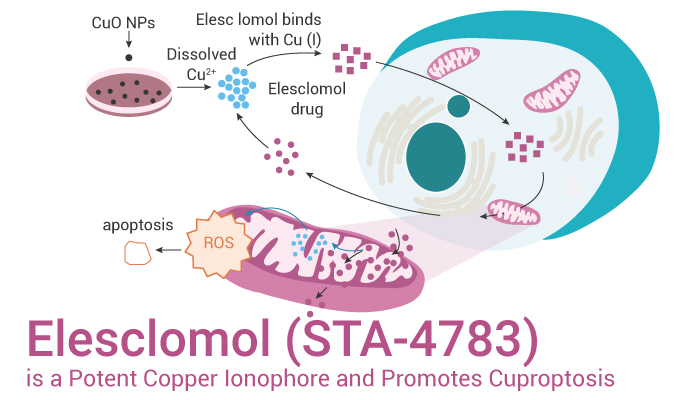Cuproptosis is a unique type of cell death that is copper-dependent. Copper is a double-edged sword. On the one hand, it is an important enzyme cofactor. On the other hand, copper excessive accumulation leads to cytotoxicity. Excessive accumulation of intracellular copper triggers the aggregation of mitochondrial lipidated proteins and the destabilization of Fe-S cluster proteins. FDX1 is an upstream regulator of protein lipidation, accompanied by a functional link between FDX1, protein lipidation machinery, and copper toxicity. Meanwhile, copper ionophores are small molecules that bind copper and shuttle copper into cells. Copper ionophores induce copper death, and act as anticancer agents. As a result, they are used in Menkes and related genetic copper deficiency studies. We’ll describe an effective copper ionophore, Elesclomol (STA-4783) here.
Elesclomol promotes copper-dependent cell death by specifically binding to ferredoxin 1 (FDX1).

Elesclomol selectively binds ferredoxin 1 (FDX1), but not the paralog protein FDX2. It binds the α2/α3 helix and β5 chain of FDX1, inhibiting FDX1-mediated biosynthesis of Fe-S clusters. Alternatively, it causes Fe-S clusterin to be lost in an FDX1-dependent manner. Additionally, Elesclomol-Cu (1:1 ratio) (40 nM; 2 hr, 24 hr) causes a 15-60-fold increase in intracellular copper levels and triggers ABC1 cell (lung cancer cells) death. It (200 nM; 18 hours) also increases the number of early and late apoptotic cells in HSB2 cells. Additionally, It induces apoptosis in cancer cells by inducing oxidative stress.
Create an Atp7b-deficient (Atp7b−/−) mouse model in which loss of Atp7b leads to intracellular copper accumulation and cell death. Treatment with Elesclomol every three days or once a week from postpartum day 5 to 26 until postpartum day 54. Elesclomol (10 mg/kg; subcutaneous injection) improves severe cardiac pathology and partially reduces hypertrophy. Besides, it resulted in an increase in cardiac [Cu] from 34% to 55% of vector knockout levels. In summary, Elesclomol escorts copper to mitochondria and increases cytochrome c oxidase levels in the brain. It prevents harmful neurodegenerative changes and improves survival in striped mice.
Taken together, Elesclomol is a potent inducer of copper death. As a copper ionophore, it can specifically bind to FDX1 and increase the level of intracellular copper ions, leading to cell death.
References:
[1] Tsvetkov P, et al. Science. 2022 Mar 18;375(6586):1254-1261.
[2] Guthrie LM, et al. Science. 2020 May 8;368(6491):620-625.
[3] Kirshner JR, et al. Mol Cancer Ther. 2008 Aug;7(8):2319-27.